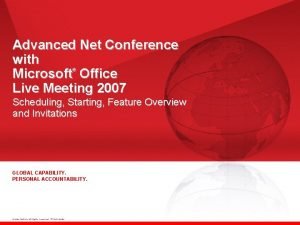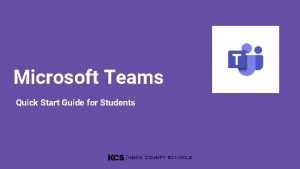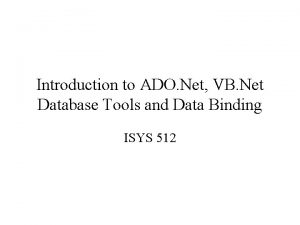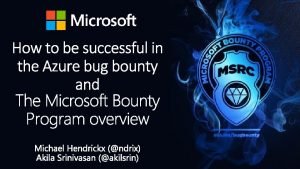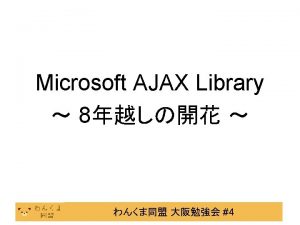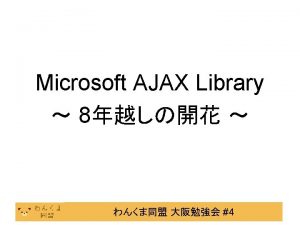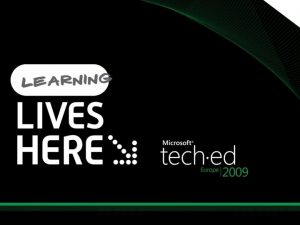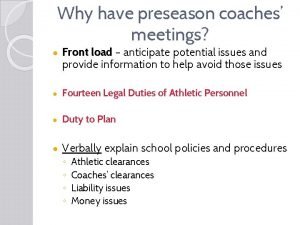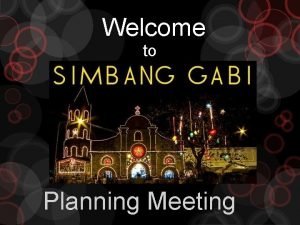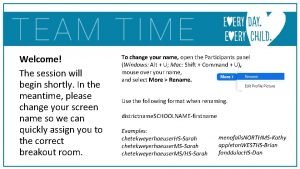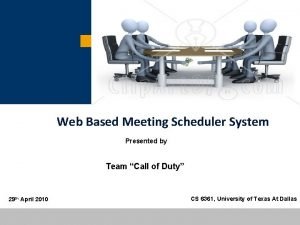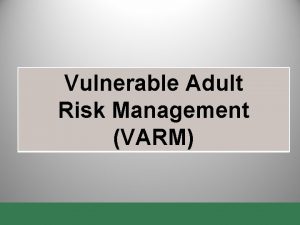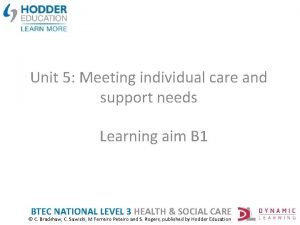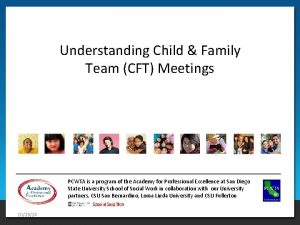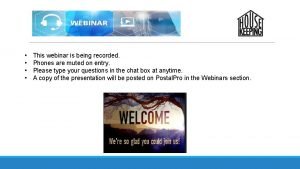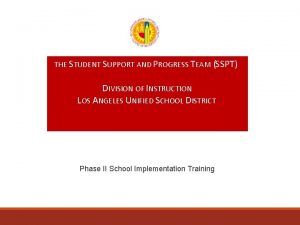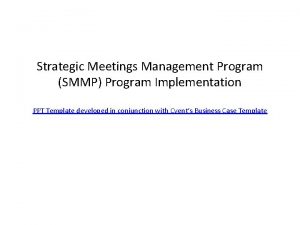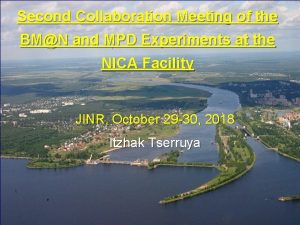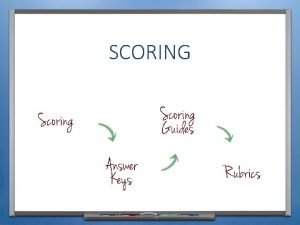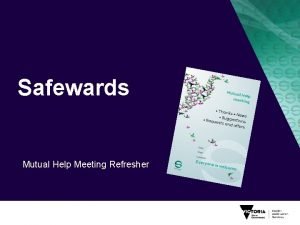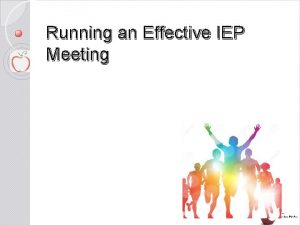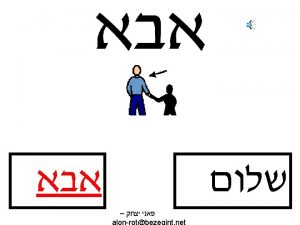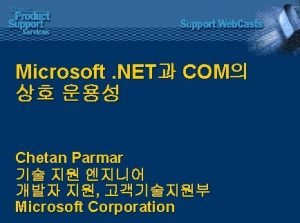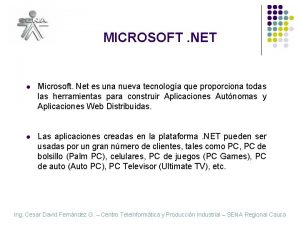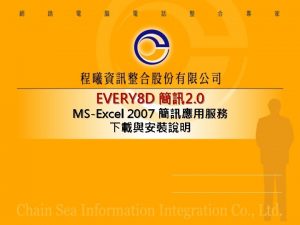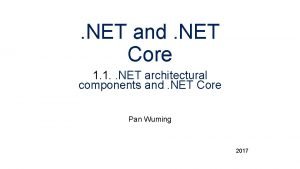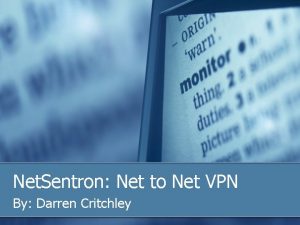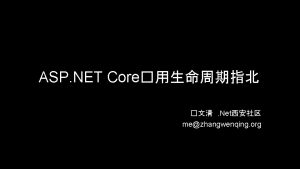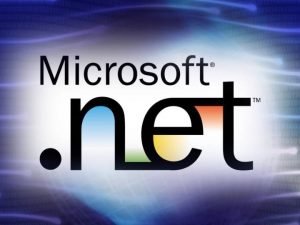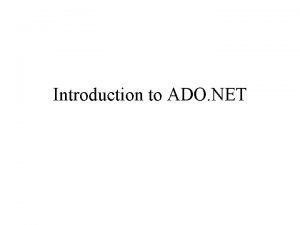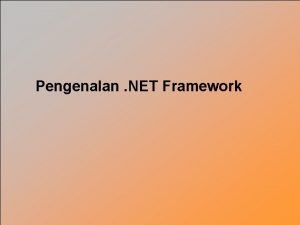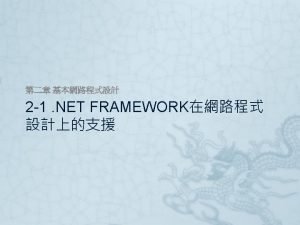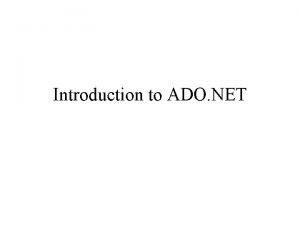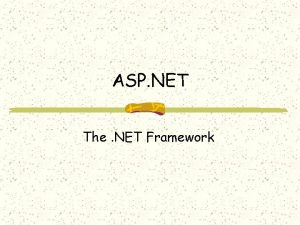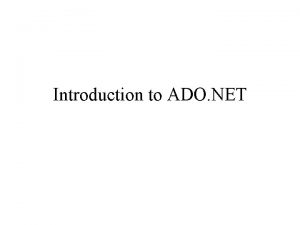Microsoft Net Meeting Microsoft What is Microsoft Net
















































- Slides: 48

Microsoft Net. Meeting

® Microsoft • What is Microsoft® • • • ® Net. Meeting® Net. Meeting Technology How to get Net. Meeting Requirements Setup and Use Tools and Features

What Is Net. Meeting? Net. Meeting enables you to communicate with others over the Internet or your local intranet. Using Net. Meeting you can: • Use data conferencing tools between an • • unlimited number of participants Use audio and video between two people Share and collaborate on applications Use tools such as chat, whiteboard, and file transfer Control the desktop remotely

Net. Meeting Technology • Microsoft Net. Meeting is a Vo. IP and multi-point videoconferencing client included in many versions of Microsoft Windows (from Windows 95 OSR 2 to Windows XP). It uses the H. 323 protocol for video and audio conferencing, and is interoperable with Open. H 323 -based. It also uses Open. H 323 a slightly modified version of the ITU T. 120 Protocol for whiteboarding, whiteboarding application sharing, sharing desktop sharing, sharing remote desktop sharing (RDS) and file transfers. The secondary Whiteboard in Net. Meeting 2. 1 and later utilizes the H. 324 protocol.

Net. Meeting Technology • • • Net. Meeting is a software application for audio and video conferencing. Net. Meeting offers sharing of desktop video, audio, chat and file transfer functionality. Net. Meeting supports directory servers and services. Net. Meeting uses may automatically register with a directory when they start their Net. Meeting client. The directory then allows users to find online users by name or location. If no directory is available, Net. Meeting users can also call each other directly by computer name or IP address Once connected to other users, Net. Meeting places all parties in a "call. " Net. Meeting tracks the call roster and allows users to share their desktop windows, to chat, transfer files, or share a Vo. IP feed.

Voice Over Internet Protocol • Vo. IP is a technology that allows telephone calls to be made over computer networks like the Internet. Vo. IP converts analog voice signals into digital data packets and supports real-time, two-way transmission of conversations using Internet Protocol (IP).

Voice Over Internet Protocol • Vo. IP calls can be made on the Internet using a Vo. IP service provider and standard computer audio systems. Alternatively, some service providers support Vo. IP through ordinary telephones that use special adapters to connect to a home computer network. Many Vo. IP implementations are based on the H. 323 technology standard.

Voice Over Internet Protocol • Vo. IP offers a substantial cost savings over traditional long distance telephone calls. The main disadvantage of Vo. IP is, like cell phones, a greater potential for dropped calls and generally lesser voice quality.

H. 323 Protocol • H. 323 is a protocol standard for multimedia communications. H. 323 was designed to support real-time transfer of audio and video data over packet networks like IP. The standard involves several different protocols covering specific aspects of Internet telephony. The International Telecommunication Union (ITU-T) maintains H. 323 and these related

H. 323 Protocol • Most voice over IP (Vo. IP) applications utilize H. 323 supports call setup, teardown and forwarding/transfer. Architectural elements of a H. 323 based system are Terminals, Multipoint Control Units (MCUs), Gateways, an optional Gatekeeper and Border Elements. Different functions of H. 323 run over either TCP or UDP.

Open. H 323 PROTOCOL • Full featured, open source implementation of the H. 323 Voice over IP protocol. The code is written in C++ and, through the development effort of numerous people around the world, fully supports the H. 323 protocol. The software has been integrated into a number of open source and commercial software products.

ITU T. 120 PROTOCOL • ITU-T recommendation that describes a series of communication and application protocols and services that provide support for real-time, multipoint data communications. It is used by products such as Cisco Web. Ex's Web. Ex Meeting. Center, Meeting. Center Microsoft Net. Meeting and Lotus Sametime to support application sharing, real-time text conferencing and other functions.

Transmission Control Protocol • Transmission Control Protocol (TCP) and Internet Protocol (IP) are two distinct network protocols, technically speaking. TCP and IP are so commonly used together, however, that TCP/IP has become standard terminology to refer to either or both of the protocols. • IP corresponds to the Network layer (Layer 3) in the OSI model, whereas TCP corresponds to the Transport layer (Layer 4) in OSI. In other words, the term TCP/IP refers to network communications where the TCP transport is used to deliver data across IP networks.

UDP Protocol • UDP is a lightweight transport built on top of IP. UDP squeezes extra performance from IP by not implementing some of the features a more heavyweight protocol like TCP offers. Specifically, UDP allows individual packets to be dropped (with no retries) and UDP packets to be received in a different order than they were sent.

Running the Startup Wizard • First screen: • • • information about Net. Meeting Second screen: user information Third screen: directory server information Fourth screen:

Startup Wizard (continued) • Fifth screen: • • • preparing for audio Sixth screen: audio setup Seventh screen: microphone setup Eighth screen: finish setup

Setting Options Items that can be configured: • Directory information • Directory settings • Network bandwidth • Gatekeeper settings • Gateway settings • Security • Audio

General Tab in Options Configurable Settings • Directory information • Directory settings • Run in background • Taskbar icon • Bandwidth and

Security Tab in Options • Encryption – Secure calls are data only • Authentication Certificates – Same security interface as Internet Explorer

Audio Tab in Options • List of supported drivers is located at: http: //www. microsoft. c om /netmeeting/ • Advanced allows you to select a preferred Codec for your sound compression

Video Tab in Options • Automatically • • send and receive video Determine send image size and quality Specify video camera to use

Deploying Net. Meeting • All these options and more can be pre- configured and rolled out with the Net. Meeting 3. 01 Resource Kit Wizard, which is available on the Microsoft Web site at: – http: //www. microsoft. com/windows/Net. Meeti ng /Corp/reskit/default. asp

Net. Meeting User Interface • • T. 120 data H. 323 audio/video Main Net. Meeting window User Interface

How to Make Direct Calls • IP • Friendly • name Secure calls

NO LONGER AVAILABLE! Using Directory Server to Call • Choosing • • • Internet Locator Service (ILS) Logging on Directory listing Initiating call

Conferencing Tools • Chat • Whiteboar • d File Transfer

Conferencing Tools (continued) • Application and • • Program sharing Desktop sharing Remote desktop sharing

How to establish a connection in MS Netmeeting for Windows XP • Press Start and then run. • Type conf • Go through the directions and fill out any • • required fields. Once you have done this press call -> New Call Type in the ip address of the person to call and press call.

How to establish a connection through a firewall • When you use Net. Meeting to establish a connection over the • • • Internet, Net. Meeting uses several IP ports to communicate with other meeting participants. Net. Meeting uses the following Internet Protocol (IP) ports: Port Purpose ------------------389 Internet Locator Server [Transmission Control Protocol (TCP)] 522 User Location Server (TCP) 1503 T. 120 (TCP) 1720 H. 323 call setup (TCP) 1731 Audio call control (TCP) Dynamic H. 323 streaming [Realtime Transport Protocol (RTP) over User Datagram Protocol (UDP)]

How to establish a connection through a firewall • To establish outbound Net. Meeting connections through a firewall, the firewall must be configured to do the following: • Pass through primary TCP connections on ports 522, 389, 1503, • 1720 and 1731 Pass through secondary UDP connections on dynamically assigned ports (1024 -65535).

How to make a video call with Net Meeting • To receive video, all of the following conditions must exist: • There must be a user capable of sending video. • The user capable of sending video must be sending • video to you. If you are receiving the video, the status in the video window should read "Receiving. " If the status reads "Paused, " you will not receive live video until you click the Play button to resume play.

How to make a video call with Net Meeting • To send video, all of the following conditions must exist: • You must have appropriate video hardware that • is compatible with Net. Meeting: a camera or a video capture board. The user sending the video should see the "Sending" status in the My Video window. Video is not sent if the status is "Paused. "

How to make a video call with Net Meeting • Making an Audio and Video Connection • Net. Meeting establishes a video connection automatically • • at the beginning of the call if the Automatically send video at the start of each call check box is selected. If you are in a data conference and do not have an audio and video connection established, you can right-click a user on the Current Call tab, and then click Switch Audio And Video. You can also click Switch on the toolbar, and then click to select the user with whom you want to establish an audio and video connection. Note that the Switch button is available only when the Current Call tab is selected.

How to Share programs in Net Meeting • Net. Meeting allows you to share programs • running on your computer with other Net. Meeting participants. Programs can be shared even when a participant does not have that program installed on his or her computer. When you are in a Net. Meeting conference, others in the conference can see and use a program running on your computer.

How to Share programs in Net Meeting • To share a program within Net. Meeting, click the Tools menu, point • • to Share Applications, and then click the program to share. Or, you can click the Net. Meeting icon on the taskbar, point to Share Application, and then click the program you want to share. Or, you can click the Share button on the toolbar displayed for the current call. When you select a program, it is seen on every other computer in the conference. The name of the program's owner is displayed in the upper- right corner of the window (if that window is not maximized). By default, you are in control of the program. You can click Collaborate on the Tools menu, or click the Collaborate button on the toolbar for the current call, to allow others to use the program. In this mode, the initials of the participant who has control are added to the mouse pointer. Any user can change or run your program after taking control of the program by double-clicking the shared program.

How to Share programs in Net Meeting • Program sharing is achieved by passing graphics, mouse movements, and keyboard inputs to the other computers in real time. Your color and resolution settings have an impact on how items are displayed on other computers. If the originator of the shared program is using 1024 x 768 screen resolution, but a participant is using 640 x 480 resolution, the participant's screen will be too small to display the whole window.

How to transfer files in Net Meeting • When you are in a Net. Meeting conference, you can • • transfer a copy of a file to every participant in the conference. You can transfer a file by dragging the file's icon to the Net. Meeting window for global file transfers (transfers to all conference members), or by pointing to a single participant. To initiate a global file transfer, you can also click File Transfer/Send File on the Tools menu. You can initiate individual file transfers by right-clicking a participant in the roster and then clicking Send File. In most cases, you see the Browse dialog box. If you use the drag method, no dialog box is visible.

How to use chat in Microsoft Net Meeting • Net. Meeting includes a Chat tool that allows • online meeting participants to communicate with each other using standard text messages. Chat is particularly useful when one or more meeting participants is unable to use the audio features of Net. Meeting. To start Chat, click Chat on the Tools menu in Net. Meeting, click the Chat button on the toolbar, or click the Chat icon on the menu from the Net. Meeting icon on the taskbar.

How to use chat in Microsoft Net Meeting • Chat includes the following features: • When one person in a meeting runs Chat, it appears on all screens. • • • Everyone in the meeting can then type messages simultaneously and see what other people are typing. You can specify the font and font size, style, and effects that are used for the messages and information display in the Chat window on your computer. You can specify the items included in the information display associated with each message in the Chat window and the format used for the messages. You can save the current contents of the Chat window so they can be opened in Net. Meeting, Microsoft Excel, or another spreadsheet or word processing program in the future.

How to make a Video Call in Net Meeting • In Microsoft Net. Meeting, you can participate in a • video conference with other Net. Meeting users. To receive video, all of the following conditions must exist: • There must be a user capable of sending video. • The user capable of sending video must be sending • video to you. If you are receiving the video, the status in the video window should read "Receiving. " If the status reads "Paused, " you will not receive live video until you click the Play button to resume play.

How to make a Video Call in Net Meeting • To send video, all of the following conditions must exist: • You must have appropriate video hardware that • is compatible with Net. Meeting: a camera or a video capture board. The user sending the video should see the "Sending" status in the My Video window. Video is not sent if the status is "Paused. "

How to make a Video Call in Net Meeting • Making an Audio and Video Connection • If you are in a data conference and do not have an audio • and video connection established, you can right-click a user on the Current Call tab, and then click Switch Audio And Video. You can also click Switch on the toolbar, and then click to select the user with whom you want to establish an audio and video connection. Note that the Switch button is available only when the Current Call tab is selected.

Where is Net. Meeting going today? • Net. Meeting helped pioneer online conferencing when • it was released in May 1996, before the advent of instant messaging (IM) and other services for realtime online communication. The software still ships as part of Windows and some of its features, such as whiteboarding and applicationsharing, are used by the MSN Messenger and Windows Messenger IM applications.

Future of Net. Meeting • Net. Meeting is no longer included with Windows • • Vista, and has been replaced by Windows Meeting Space and Microsoft office Live Meeting. However, a hot fix for Vista was published by Microsoft on March 22, 2007. The hot fix contains an installer package to install Net. Meeting 3. 02 on Windows Vista business, enterprise or ultimate versions. Version 3. 02 is essentially a port of 3. 01 to Vista. Net meeting doesn't work with Vista Home edition.

Future of Net. Meeting • Net. Meeting can still be installed and run on Windows Vista. A hotfix for Vista was published by Microsoft on March 22, 2007 can obtain this hotfix by contacting Microsoft Support. The hotfix contains an installer package to install Net. Meeting 3. 02 on Windows Vista business, enterprise or ultimate versions. Version 3. 02 is essentially a port of 3. 01 to Vista. Netmeeting doesn't work with Vista Home edition.

Future of Net. Meeting • • Microsoft plans to phase Net. Meeting out and remove it from its Web site. The Net. Meeting directory is already gone, which means that users have to type in the IP address of the person they want to conference with or use another online directory service There is no time-frame for the Net. Meeting phase-out. It appears that it will be a gradual transition. Many businesses still use Net. Meeting, although IM and Web conferencing products outclass it in terms of usability, analysts said.

Future of Net. Meeting • • Before video service became common on free IM clients, such as Yahoo! Messenger and MSN Messenger, Messenger Net. Meeting was a popular way to perform videoconferences and chatting over the Internet (with the help of public ILS servers, or "direct-dialing" to an IP address). Since the release of Windows XP, Microsoft has deprecated it in favor of Windows Messenger and Microsoft Office Live Meeting, Meeting although it is still installed by default (Start : Run. . . : C: Program FilesNet. Meetingconf. exe). Note that Windows Messenger, Messenger MSN Messenger and Windows Live Messenger hooks directly into Net. Meeting for the application sharing, desktop sharing, and Whiteboard features exposed by each application.

For More Information • http: //www. microsoft. com/window • s/netmeeting/ http: //www. microsoft. com/window s/Net. Meeting/Corp/reskit/default. a sp
 For today's meeting
For today's meeting Today meeting or today's meeting
Today meeting or today's meeting What is meeting and types of meeting
What is meeting and types of meeting What is meeting and types of meeting
What is meeting and types of meeting Office live meeting 2007
Office live meeting 2007 Ms teams quick start guide
Ms teams quick start guide Achmed lach net
Achmed lach net Ado.net vb.net
Ado.net vb.net Microsoft asp.net core privilege escalation (march 2018)
Microsoft asp.net core privilege escalation (march 2018) 大阪 microsoft asp.net
大阪 microsoft asp.net 大阪 microsoft asp.net
大阪 microsoft asp.net Microsoft net framework 4
Microsoft net framework 4 Microsoft official academic course microsoft word 2016
Microsoft official academic course microsoft word 2016 Microsoft official academic course microsoft excel 2016
Microsoft official academic course microsoft excel 2016 Microsoft edge startwarren theverge
Microsoft edge startwarren theverge Microsoft excel merupakan program aplikasi .......
Microsoft excel merupakan program aplikasi ....... Microsoft official academic course microsoft word 2016
Microsoft official academic course microsoft word 2016 Preseason coaches meeting agenda
Preseason coaches meeting agenda Quality is meeting or exceeding customer expectations
Quality is meeting or exceeding customer expectations Iep meeting quotes
Iep meeting quotes Prayer for planning session
Prayer for planning session Meeting will start shortly
Meeting will start shortly Housekeeping meeting agenda
Housekeeping meeting agenda Meeting initiator
Meeting initiator Football meeting agenda
Football meeting agenda What is varm
What is varm Unit 5 meeting individual needs
Unit 5 meeting individual needs What is a cft meeting
What is a cft meeting What is a cft
What is a cft Meeting wise checklist
Meeting wise checklist This webinar is being recorded
This webinar is being recorded Julian beever meeting mr frog
Julian beever meeting mr frog Lausd sspt handbook
Lausd sspt handbook 27 chapter outline hunger games
27 chapter outline hunger games The great gatsby how does nick meet tom's mistress
The great gatsby how does nick meet tom's mistress Ki runga ki raro karakia
Ki runga ki raro karakia Tata cara technical meeting lomba
Tata cara technical meeting lomba Strategic meetings management software
Strategic meetings management software Approaching meeting exceeding
Approaching meeting exceeding Skype meeting broadcast portal
Skype meeting broadcast portal Present tense of
Present tense of I ______ to the mall after school.
I ______ to the mall after school. Graduation meeting agenda
Graduation meeting agenda Mpd collaboration meeting
Mpd collaboration meeting Exceeding meeting approaching
Exceeding meeting approaching Pre-meeting email template
Pre-meeting email template Safewards mutual help meeting
Safewards mutual help meeting Iep meeting agenda
Iep meeting agenda Technical rundown
Technical rundown




